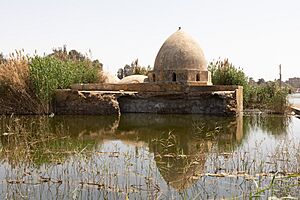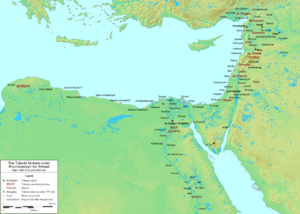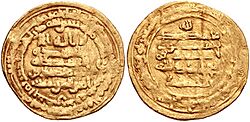Muhammad ibn Tughj al-Ikhshid facts for kids
Quick facts for kids Muhammad ibn Tughj al-Ikhshid |
|
|---|---|
| Hereditary emir of Egypt, Syria and the Hejaz | |
| Rule | 26 August 935 – 24 July 946 |
| Successor | Unujur |
| Born | 8 February 882 Baghdad |
| Died | 24 July 946 (aged 64) Damascus |
| Burial | Jerusalem |
| Dynasty | Ikhshidid dynasty |
| Father | Tughj ibn Juff |
| Religion | Sunni Islam |
Muhammad ibn Tughj al-Ikhshid (born February 8, 882 – died July 24, 946) was an important leader in the Middle East. He was a commander and governor for the Abbasid Caliphate, a large Islamic empire. After 939, he became known by his special title, al-Ikhshid.
From 935 until his death in 946, al-Ikhshid ruled Egypt and parts of Syria (the Levant) on his own. He started the Ikhshidid dynasty, a family line that ruled these areas until 969. His time as ruler brought a rare period of peace and good government to early Islamic Egypt.
Contents
Early Life and Rise to Power
Muhammad ibn Tughj was born in Baghdad on February 8, 882. His family came from the Farghana Valley in Transoxiana, a region in Central Asia. They were of Turkic origin and claimed royal ancestors.
Muhammad's grandfather and father, Tughj ibn Juff, served the Abbasid rulers. Later, Tughj worked for the Tulunids, who were the independent rulers of Egypt and Syria. Muhammad grew up in Syria, learning about military and government from his father. He even served as his father's assistant governor in Tiberias.
A Difficult Start
Muhammad's early career was not easy. In 905, he and his father were put in prison by the Abbasids. They were freed in 906. Muhammad was involved in the death of the vizier (a high-ranking minister) al-Abbas ibn al-Hasan al-Jarjara'i in 908. After this, he left Iraq and began working for the governor of Egypt, Takin al-Khazari.
He gained the support of powerful Abbasid leaders, especially the commander-in-chief Mu'nis al-Muzaffar. This support helped him become governor first of Palestine and then of Damascus. In 933, he was briefly made governor of Egypt, but this order was cancelled. He had to fight to keep his position as governor of Damascus.
Taking Control of Egypt
In 935, Muhammad ibn Tughj was again appointed governor of Egypt. He quickly moved to take control. He organized an invasion by land and sea. His fleet captured Tinnis and the Nile Delta, then moved towards the capital, Fustat.
He defeated the current governor, Ahmad ibn Kayghalagh, who fled. Muhammad ibn Tughj entered Fustat on August 26, 935, and became the new ruler of Egypt.
Defeating the Fatimid Invasion
After taking control, al-Ikhshid faced an invasion from the Fatimid Caliphate. The Fatimids were a rival Islamic group from North Africa. They attacked Egypt, capturing Alexandria in March 936.
However, al-Ikhshid's brother, al-Hasan, defeated the Fatimid forces. They were driven out of Alexandria and forced to retreat. Al-Ikhshid was known for stopping his troops from looting, which showed he planned to stay in Egypt for a long time.
Ruling Egypt and Gaining a Title

In 936, al-Ikhshid reported to the Caliph al-Radi that he had defeated the Fatimids and was improving Egypt's finances. The Caliph confirmed his position. The Fatimid threat actually helped al-Ikhshid, as the Caliphs approved his rule in exchange for his support against the Fatimids.
In 938, al-Ikhshid asked for the special title (laqab) of al-Ikhshid. This title was used by the rulers of his family's homeland, Farghana. Caliph al-Radi granted his request in 939. From then on, he was known as al-Ikhshid.
Peace and Stability in Egypt
Al-Ikhshid's rule brought peace and order to Egypt. Unlike previous times, there were few reports of Bedouin raids, city riots, or military revolts. This shows he was successful in bringing stability.
He was described as a strong and wise leader who planned well for wars. He treated his soldiers with respect and ruled fairly. He also built up a strong army of his own, including Turkic and Black African slave soldiers.
Controlling Syria and Foreign Relations
As a ruler, al-Ikhshid was patient and careful. He used diplomacy and his connections in Baghdad as much as military force. He tried to avoid direct battles when possible. His main goal was to secure Egypt and make sure his family could rule it for generations. Syria was important because it protected Egypt from invasions from the east.
Conflicts with Other Leaders
Al-Ikhshid's control over Syria was often challenged. After driving the Fatimids out of Egypt, his troops occupied all of Syria up to Aleppo. He even made an agreement with the Banu Kilab tribe to strengthen his hold on northern Syria.
In 937, he received a special visit from the Byzantine Emperor, Romanos I Lekapenos. This was to arrange an exchange of prisoners. This was a great honor and showed that al-Ikhshid was seen as an independent ruler, even though the exchange was done in the Caliph's name.
Later, a powerful leader from Baghdad named Muhammad ibn Ra'iq tried to take control of Syria. Al-Ikhshid fought against him. After some battles, they agreed to divide Syria: al-Ikhshid would control the southern parts (including Ramla), and Ibn Ra'iq the northern parts. Al-Ikhshid even paid Ibn Ra'iq an annual tribute. This agreement was sealed by a marriage between Ibn Ra'iq's son and al-Ikhshid's daughter.
Dealing with the Hamdanids
The peace did not last long. After Ibn Ra'iq was killed, the Hamdanid dynasty from Mosul tried to take over Syria. Al-Ikhshid again led his army into Syria, taking back control of Damascus.
In 944, al-Ikhshid met Caliph al-Muttaqi in Raqqa. The Caliph had fled Baghdad because of powerful leaders trying to control him. Al-Ikhshid tried to convince the Caliph to come to Egypt, but he refused. However, al-Ikhshid secured an important agreement. The Caliph recognized al-Ikhshid's authority over Egypt, Syria, and the Hejaz (which included the holy cities of Mecca and Medina) for thirty years. This agreement also gave his sons the right to rule after him.
After al-Ikhshid returned to Egypt, the ambitious Hamdanid prince Sayf al-Dawla captured Aleppo and northern Syria. Al-Ikhshid sent his armies, but they were defeated. He then had to campaign in person in 945. He defeated the Hamdanids near Qinnasrin and recaptured Aleppo.
A Lasting Agreement
In October 945, al-Ikhshid and Sayf al-Dawla made a new agreement. Al-Ikhshid accepted Hamdanid control over northern Syria and agreed to pay them an annual tribute. In return, Sayf al-Dawla gave up his claims on Damascus and southern Syria.
For al-Ikhshid, controlling Damascus and southern Syria was more important than Aleppo. This region was Egypt's main defense against attacks from the east. By letting the Hamdanids control northern Syria, al-Ikhshid created a buffer state. This state would protect Egypt from invasions from Iraq and the Byzantine Empire. This border agreement lasted for a long time, even after both dynasties were gone.
Death and Legacy
Al-Ikhshid died in Damascus on July 24, 946. His body was taken to Jerusalem and buried near the Temple Mount. His son, Unujur, became the new ruler. This happened smoothly because of the powerful commander-in-chief, Abu al-Misk Kafur.
Kafur was one of the many Black African slave soldiers recruited by al-Ikhshid. He became the most important minister and virtual ruler of Egypt for 22 years. He ruled on his own from 966 until his death in 968. After Kafur died, the Fatimids invaded and conquered Egypt in 969, starting a new chapter in Egypt's history.
Medieval historians saw many similarities between al-Ikhshid and the earlier Tulunid rulers. However, al-Ikhshid was known for being more cautious and practical. He focused on securing Egypt and his family's rule, rather than trying to control the entire Caliphate. He was not a major builder or a patron of arts like some other rulers, but he brought stability and good governance to Egypt.
See also
- 10th century in Lebanon



